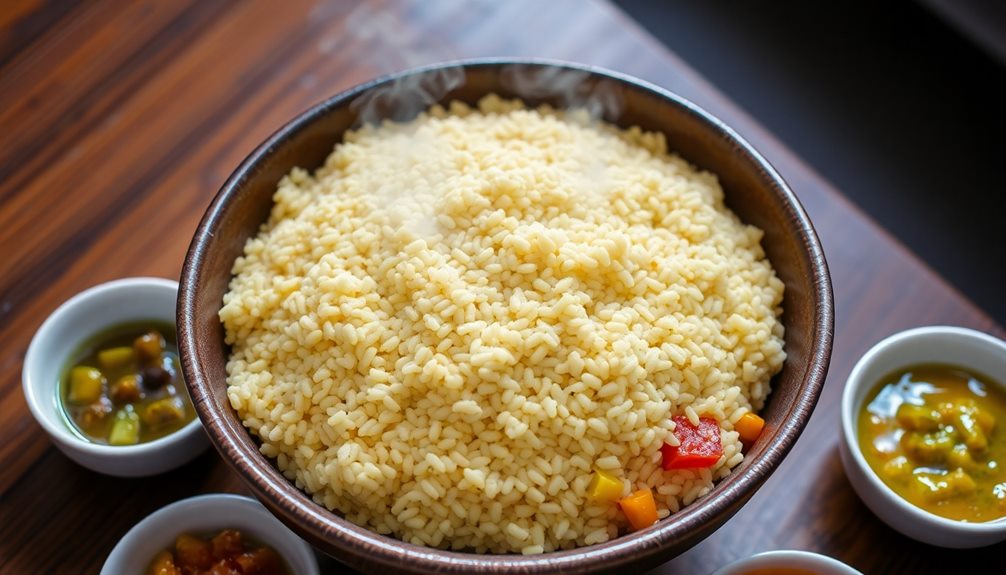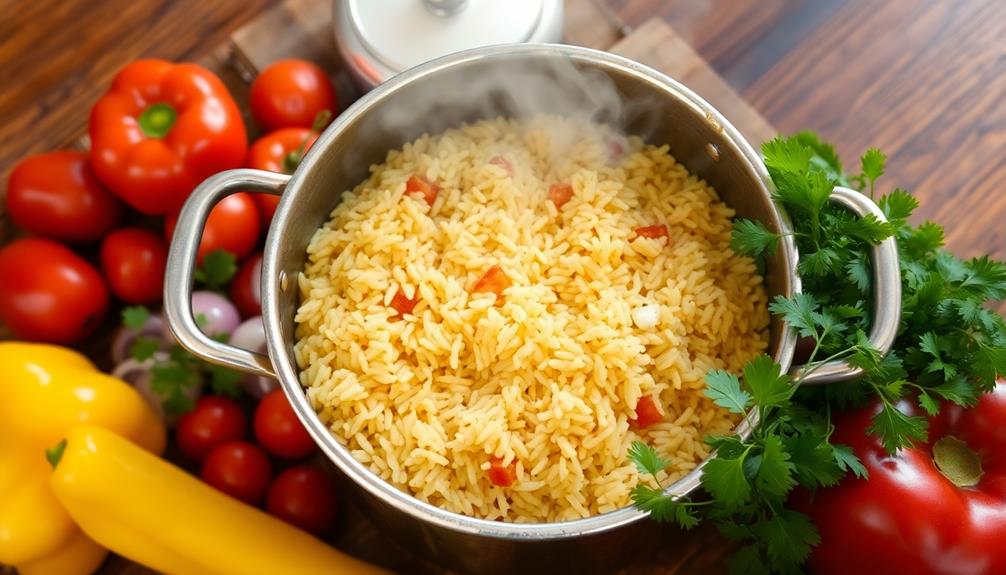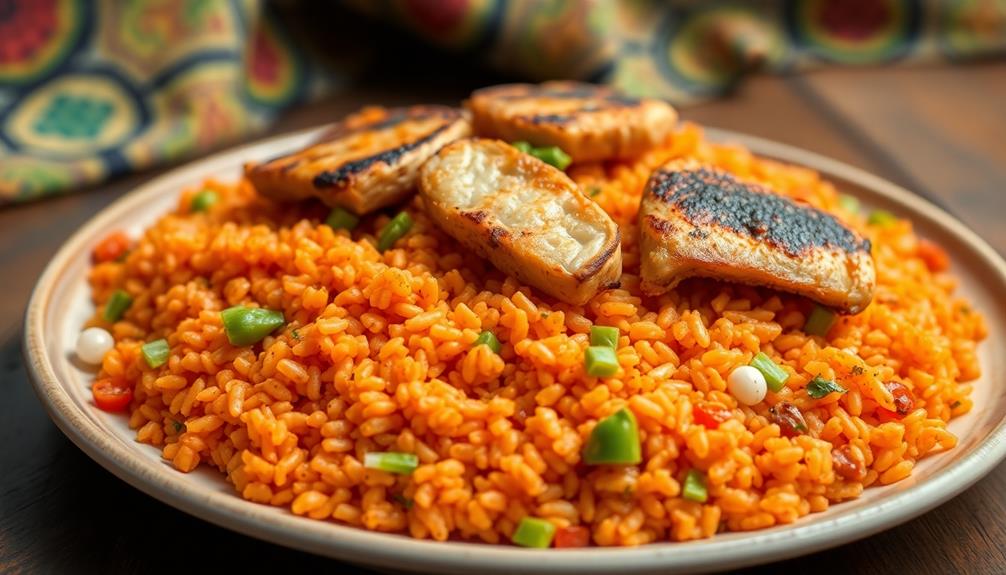Sadza, Zimbabwe’s cherished staple dish, has nourished families for generations. This comforting porridge-like delicacy’s roots reach back centuries, blending indigenous culinary traditions with the flavors of ground cornmeal. To make sadza, you’ll start by bringing water to a full rolling boil, then gradually add the cornmeal while stirring continuously to prevent lumps. As the mixture thickens, you’ll cover and simmer it, allowing the flavors to meld. Served hot with a savory relish, sadza is a beloved centerpiece of Zimbabwean cuisine, symbolizing community and cultural identity. If you’d like to learn more about this delightful dish, keep reading.
Key Takeaways
- Sadza is a centuries-old staple dish in Zimbabwe, rooted in the country’s indigenous culinary traditions and often accompanied by stews or vegetables.
- The preparation process involves gradually adding cornmeal to boiling water while continuously stirring to achieve a smooth, creamy texture.
- Cooking sadza requires patience and attention, with simmering and stirring essential steps to develop the desired thickness and flavor.
- Sharing sadza symbolizes community bonding and cultural significance, and it is often served hot with a complementary relish or stew.
- Sadza embodies Zimbabwe’s rich food culture and tradition, representing nourishment, warmth, and a testament to the country’s culinary heritage.
History

Sadza’s history dates back centuries, rooted in the culinary traditions of Zimbabwe’s indigenous people. This beloved staple dish evolved from the ground corn or millet flour that local communities have been cultivating and consuming for generations.
Over time, the preparation process refined, with families passing down their secret recipes and techniques from one generation to the next.
Today, sadza remains a central part of Zimbabwean cuisine and culture. Its comforting, filling nature makes it a cherished meal, often accompanied by savory stews, grilled meats, or fresh vegetables.
The act of sharing sadza together is more than just eating – it’s a time-honored tradition that brings families and communities closer. Whether enjoyed during special celebrations or as a daily sustenance, this humble dish continues to nourish both bodies and souls across Zimbabwe.
Recipe_

Sadza, a staple dish in Zimbabwe, is a thick porridge made from finely ground maize flour. It’s a comforting and nourishing food that has been a part of Zimbabwean cuisine for generations. Sadza is often served with a variety of relishes, stews, or grilled meats, creating a satisfying and well-balanced meal.
The process of preparing sadza involves careful attention to detail and patience. The key is to achieve the perfect consistency, which can be slightly different depending on personal preferences and regional variations.
Ingredients:
- 2 cups maize flour (finely ground)
- 4 cups water
- 1 teaspoon salt
To Cook:
In a large saucepan, bring the 4 cups of water to a boil. Gradually add the maize flour, stirring constantly with a wooden spoon to prevent lumps from forming. Reduce the heat to low and continue stirring the mixture until it thickens to your desired consistency, usually about 10-15 minutes. Add the salt and stir well.
When the sadza has reached the desired thickness, you can serve it immediately, or cover and keep it warm until ready to serve.
Sadza is commonly enjoyed with a variety of relishes, such as vegetables, meat stews, or a simple side of grilled or fried fish.
Cooking Steps

Prepare the cornmeal by slowly pouring it into a pot of simmering water, stirring constantly to prevent lumps from forming.
Once the cornmeal has thickened, reduce the heat and continue stirring for about 10 minutes, until the sadza reaches the desired consistency. It should have a smooth, creamy texture.
Next, scoop the sadza into a serving bowl. Use a wooden spoon to create a well in the center, which will be filled with your chosen relish or stew.
For a traditional accompaniment, try a savory vegetable or meat-based stew. Ladle the stew into the well, allowing it to mingle with the sadza.
Grab a spoon and dig in, scooping up the flavorful combination of the comforting cornmeal and the tantalizing stew.
Savor each bite, appreciating the harmony of textures and tastes that make sadza a beloved Zimbabwean staple.
Step 1. Bring Water to Rolling Boil

Begin by bringing a large pot of water to a full rolling boil over high heat. This is the crucial first step in preparing delicious sadza, Zimbabwe’s beloved staple dish.
You’ll want the water to be bubbling vigorously, with rapid, continuous movement throughout the pot. This high heat is essential for cooking the sadza flour to perfection.
Once the water is at a full boil, it’s time to slowly sprinkle in the sadza flour, while constantly stirring the mixture with a wooden spoon or whisk.
The key is to add the flour gradually, a little at a time, to prevent lumps from forming. Keep stirring and incorporate the flour thoroughly. The sadza will thicken quickly, transforming from a thin, watery consistency to a thick, smooth paste.
Maintain the high heat throughout this process, ensuring the sadza cooks evenly and develops the desired texture.
With the right technique, you’ll end up with a rich, creamy sadza that’s ready to be enjoyed as the comforting centerpiece of your meal.
Step 2. Add Cornmeal to Boiling Water

With the water at a vigorous boil, you’ll want to gradually add the cornmeal. Start by sprinkling in a small amount, stirring constantly to prevent lumps from forming.
As you continue to add the cornmeal, you’ll notice the mixture thickening quickly. Keep stirring vigorously to ensure a smooth, lump-free consistency.
It’s important to add the cornmeal slowly, about a quarter cup at a time, allowing each addition to fully incorporate before adding more. This gradual approach helps the sadza develop its signature thick, creamy texture.
Be patient and keep a close eye on the pot, as the cornmeal can quickly go from perfectly cooked to burnt if you don’t stay attentive.
Once all the cornmeal has been added, continue cooking the sadza, stirring frequently, until it reaches your desired consistency. The cornmeal will continue to absorb the hot liquid, transforming into a rich, velvety porridge that’s ready to be served.
Step 3. Stir Continuously Until Thickened

Continuously stir the thickening sadza, ensuring it cooks through evenly. As you whisk the cornmeal mixture, you’ll notice it start to transform from a watery consistency to a thick, porridge-like texture.
Don’t stop stirring! This constant motion helps the sadza develop its signature creamy, smooth mouthfeel. Keep a close eye and adjust the heat as needed to prevent burning or sticking to the bottom of the pot.
The key is to stir persistently until the sadza reaches your desired thickness. This can take 5-10 minutes, so be patient and put in the effort.
You’ll know it’s ready when the mixture becomes dense and pulls away from the sides of the pot as you stir. At this point, the sadza should have a soft, pillowy consistency that’s easy to scoop and serve.
Congratulations, you’ve now mastered the art of thickening this beloved Zimbabwean staple. Get ready to enjoy the comforting, filling results of your hard work!
Step 4. Cover and Simmer

Once the sadza has reached the desired thick, creamy consistency from your persistent stirring, you can now cover the pot and let it simmer.
This step is crucial to fully cook the cornmeal and develop its comforting, porridge-like texture. Cover the pot with a tight-fitting lid, leaving a small gap for steam to escape.
Turn the heat down to low, allowing the sadza to gently simmer for 10-15 minutes. This gradual cooking process allows the starch granules to swell and the flavors to meld together, creating the signature smooth and velvety mouthfeel.
Resist the urge to lift the lid too often, as this can disrupt the simmering and cause the sadza to become lumpy. Instead, let the pot do its work, filling your kitchen with the delightful aroma of this beloved Zimbabwean staple.
After the simmering is complete, your sadza will be ready to serve, warm and inviting, a true taste of Zimbabwean home cooking.
Step 5. Serve Sadza Hot, With Relish

Upon completing the simmering, it’s time to serve the sadza hot, accompanied by a relish or stew of your choice.
Grab your bowl and ladle up a generous portion of the smooth, creamy sadza. Don’t be shy – this dish is meant to be enjoyed heartily! The key is to serve it piping hot, so the texture is just right.
Pair it with a flavorful relish, like a tomato-onion salsa or a spicy peanut stew. The contrast of the warm, comforting sadza and the zesty, tangy relish is simply divine.
Take your first bite and let the flavors dance on your tongue. The slight chewiness of the sadza balanced by the burst of acidity from the relish is a true delight.
Savor each mouthful, feeling the nourishing warmth spread through your body. This is a meal that feeds both the stomach and the soul, a taste of Zimbabwe’s rich culinary heritage.
Final Thoughts

Zimbabwe’s sadza dish exemplifies the country’s rich culinary heritage and cultural identity. As you’ve learned, sadza is more than just a simple porridge – it’s a beloved staple that brings families and communities together.
Whether enjoyed with savory relishes or sweet toppings, this comforting dish is a true taste of Zimbabwean hospitality. Made from maize meal and often paired with vegetables, meat, or sauces, this staple food can be customized to suit any palate. For a creative twist, consider exploring African yam cooking ideas to introduce new textures and flavors to your meal. Versatile and delicious, the dish is a reflection of the rich culinary heritage passed down through generations.
One of the best things about sadza is its versatility. It can be prepared in countless ways, allowing home cooks to put their own spin on this traditional favorite.
From creamy, smooth textures to heartier, chunkier varieties, there’s a sadza to suit every palate. And the range of accompaniments, from saucy stews to tangy pickles, means you’ll never tire of this staple.
As you savor your next plate of sadza, take a moment to appreciate the generations of Zimbabweans who’ve cherished this dish.
It’s a testament to the country’s vibrant food culture and the power of simple, nourishing fare to bring people together.
Embrace the comfort and community that sadza represents – it’s a true taste of Zimbabwe.
Frequently Asked Questions
How Long Does It Take to Prepare Sadza?
Preparing sadza takes around 30-45 minutes. You’ll need to simmer the corn flour in water, stirring constantly until it reaches the desired thick consistency. The exact time may vary depending on the quantity you’re making.
What Are the Health Benefits of Eating Sadza?
Eating sadza provides key nutrients like carbohydrates, fiber, and minerals. It’s a filling and satisfying dish that can help you feel fuller for longer, supporting a healthy diet. Plus, it’s a traditional part of Zimbabwean cuisine and culture.
Can Sadza Be Served With Any Type of Relish?
Yes, you can serve sadza with a variety of relishes. From savory meat stews to tangy vegetable dishes, the versatile sadza pairs well with an array of complementary flavors to create a satisfying and nourishing meal.
Is Sadza Suitable for Vegetarians or Vegans?
Yes, sadza can be suitable for vegetarians and vegans. You can serve it with plant-based relishes like peanut butter, vegetable stew, or sautéed greens, making it a versatile and nourishing option for those following a meat-free diet.
Does Sadza Have Any Cultural Significance in Zimbabwe?
Sadza holds deep cultural significance in Zimbabwe. It’s more than just a staple dish – it’s a unifying element that connects the nation, crossing ethnic and social boundaries. Zimbabweans take pride in their cherished sadza tradition.









